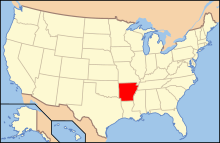
Paleontology in Arkansas refers to paleontological research occurring within or conducted by people from the U.S. state of Arkansas. The fossil record of Arkansas spans from the Ordovician to the Eocene.[1] Nearly all of the state's fossils have come from ancient invertebrate life.[1] During the early Paleozoic, much of Arkansas was covered by seawater. This sea would come to be home to creatures including Archimedes, brachiopods, and conodonts. This sea would begin its withdrawal during the Carboniferous, and by the Permian the entire state was dry land. Terrestrial conditions continued into the Triassic, but during the Jurassic, another sea encroached into the state's southern half. During the Cretaceous the state was still covered by seawater and home to marine invertebrates such as Belemnitella.[2] On land the state was home to long necked sauropod dinosaurs, who left behind footprints and ostrich dinosaurs such as Arkansaurus.[3]
During the Cenozoic the state's seas were inhabited by marine invertebrates and sharks, although the waters were gradually shrinking away. During the Ice Age, the state's climate cooled. Local grasslands and forests spread that were inhabited by creatures such as mammoths, mastodons, and giant ground sloths.
- ^ a b Cite error: The named reference
50states-arkansas-95was invoked but never defined (see the help page). - ^ Kennedy, W. J.; Cobban, W. A. (May 1993). "Ammonites from the Saratoga Chalk (Upper Cretaceous), Arkansas". Journal of Paleontology. 67 (3): 404–434. doi:10.1017/s002233600003688x. ISSN 0022-3360. S2CID 131239610.
- ^ Hunt-Foster, ReBecca (2018). "Paleobiogeographical Implications of a New Ornithomimosaur Dinosaur from the Early Cretaceous Trinity Group of Arkansas". Geological Society of America Abstracts with Programs. Geological Society of America. doi:10.1130/abs/2018sc-310439.
{{cite journal}}: Cite journal requires|journal=(help)